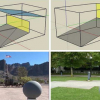Free Online Productivity Tools
i2Speak
i2Symbol
i2OCR
iTex2Img
iWeb2Print
iWeb2Shot
i2Type
iPdf2Split
iPdf2Merge
i2Bopomofo
i2Arabic
i2Style
i2Image
i2PDF
iLatex2Rtf
Sci2ools
ICCV
2009
IEEE
2009
IEEE
Color Constancy using 3D Scene Geometry
The aim of color constancy is to remove the effect of the
color of the light source. As color constancy is inherently
an ill-posed problem, most of the existing color constancy
algorithms are based on specific imaging assumptions such
as the grey-world and white patch assumptions.
In this paper, 3D geometry models are used to determine
which color constancy method to use for the different geo-
metrical regions found in images. To this end, images are
first classified into stages (rough 3D geometry models). Ac-
cording to the stage models, images are divided into differ-
ent regions using hard and soft segmentation. After that, the
best color constancy algorithm is selected for each geome-
try segment. As a result, light source estimation is tuned to
the global scene geometry. Our algorithm opens the pos-
sibility to estimate the remote scene illumination color, by
distinguishing nearby light source from distant illuminants.
Experiments on large scale image datasets show...
| Added | 13 Jul 2009 |
| Updated | 10 Jan 2010 |
| Type | Conference |
| Year | 2009 |
| Where | ICCV |
| Authors | Rui Lu, Arjan Gijsenij, Theo Gevers |
Comments (0)

